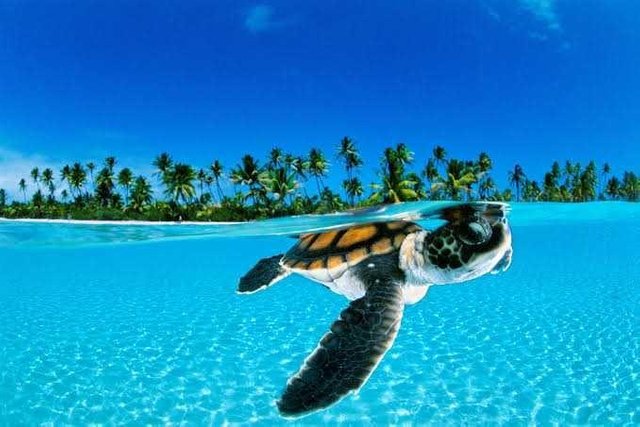THE FACTS ABOUT SEA TURTLES

Sea turtles are one of the Earth's most ancient creatures. The seven species that can be found today have been around for 110 million years, since the time of the dinosaurs. The sea turtle's shell, or "carapace" is streamlined for swimming through the water. Unlike other turtles, sea turtles cannot retract their legs and head into their shells. Their color varies between yellow, greenish and black depending on the species.

DIET
What sea turtles eat depends on the subspecies, but some common items include jellyfish, seaweed, crabs, shrimp, sponges, snails, algae and mollusks.
BEHAVIOR
Sea turtles spend most of their lives in the water, where not much information can be gathered on their behavior. Most of what is known about sea turtle behavior is obtained by observing hatchlings and females that leave the water to lay eggs. Sea turtles, like salmon, will return to the same nesting grounds at which they were born. When females come to the shore they dig out a nest in the ground with their back flippers, bury their clutch of eggs and return to the ocean. After hatching, the young may take as long as a week to dig themselves out of the nest. They emerge at night, move toward the ocean and remain there, solitary, until it is time to mate.
POPULATION
It is difficult to find population numbers for sea turtles because male and juvenile sea turtles do not return to shore once they hatch and reach the ocean, which makes it hard to keep track of them.
RANGE
Sea turtles are found in all warm and temperate waters throughout the world and migrate hundreds of miles between nesting and feeding grounds. Most sea turtles undergo long migrations, some as far as 1400 miles, between their feeding grounds and the beaches where they nest.
REPRODUCTION
Temperature: Temperatures of the sand where the turtles nest determine the sex of the turtle: below 85 degrees Fahrenheit (30ºC) is predominately male; above 85 degrees Fahrenheit (30ºC) is predominately female.
Mating Season: March-October depending on the species.
Gestation: 6-10 weeks.
Clutch size: Between 70-190 eggs depending on the species.
When the young hatch out of their eggs, they make their way to the ocean. Few survive to adulthood.
Hi @helmyandreza and thank you for sharing this informative post on sea turtles. I am a great lover of the sea, that is, looking at it, but as for going anywhere near it that is a no-go for me, purely because of what swims in it.
I am feared to death of some of the creatures linked to the ocean, however after reading this about the turtles I am warming to the idea of maybe dipping my toe in at the edge of the water for starters to pluck up some courage and take it from there, who knows I may let the water up to my knees.. LOL Take care @racykacy
Hi @racykacy. You are kind person.
I like what you said. When I child I sometimes see the turtles in the ocean when I go by my boat. But I dont see them around 10 years ago. I really care about animal thats why I post this fact
I too care about animals and glad you posted this fact. Stay safe @racykacy
Tourtase
Brother human is also a social animal
Hehe
You r right... hahaha
Hi! I am a robot. I just upvoted you! I found similar content that readers might be interested in:
https://defenders.org/sea-turtles/basic-facts
World of Photography Beta V1.0
>Learn more here<
Thank you for participating in #animalphotography
You have earned 5.05 XP for sharing your photo!
Daily photos: 1/2
Daily comments: 0/5
Multiplier: 1.01
Server time: 14:16:11
Total XP: 5.05/100.00
Total Photos: 1
Total comments: 0
Total contest wins: 0
Follow: @photocontests
Join the Discord channel: click!
Play and win SBD: @fairlotto
Daily Steem Statistics: @dailysteemreport
Learn how to program Steem-Python applications: @steempytutorials
Developed and sponsored by: @juliank